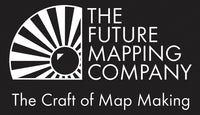Your maps are always so beautifully coloured - why is colour so important to Future Mapping Company maps?
We like to make an impact with colour to give our maps a ‘wall art’ feel so colour is a massive part of the design process. The lithographic print process we use is a fantastic way to print as there is no need to compromise - you can use whatever colour you want, including special inks such as metallics and fluorescents.
How, or where, do you start when deciding the colours for a map?
We choose colours that we like and ones that we think work together, alas there is no formula as they develop organically - it's as much about a feeling of what is right for that particular map or projection. We do tend to use metallics for the seas to mimic a bit of fluidity but, apart from that, the colours are our artistic license – it’s the really fun bit of map making.
We see you did a black and white map, why did you go monochrome?
Everybody knows somebody who loves black and will choose this colour over any other so the monochrome map was for them; somebody who likes our style but not necessarily our use of bold colours. It has been a real hit and compliments our other maps nicely.
It's probably a difficult question to answer but what is your favourite colour?
Yep you’re right, it’s impossible! Personally I love how colours work together, how one colour plays off another - particularly if at first you think it shouldn't, but strangely it does! All of our inks are mixed by hand at the printers so occasionally it can be really frustrating when a colour is out by a shade or two, but that's the nature of the way we print, it’s a real craft and it certainly adds to the fun (tension!) on printing days.








